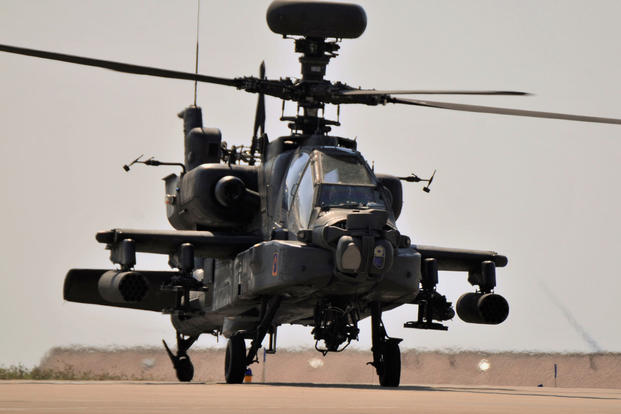The U.S. Army has no current plans to replace its Cold-War era AH-64 Apache, a still-lethal attack helicopter that the service plans to fly into combat for at least another three decades, according to the head of Army aviation.
"Right now, it's an incredibly capable aircraft that we know we are going to be flying well into the 40s," Maj. Gen. William Gayler, who commands the Army's Aviation Center of Excellence and Fort Rucker, Alabama, told an audience Wednesday at the Association of the United States Army's Aviation Hot Topic event.
Gayler's comments on the future of the AH-64 offer a new perspective on the Army's evolving Future Vertical Lift program. FVL is the third priority under the Army's bold new modernization plan, and until now Army leaders have focused on talking about the program's goals of building a new long-range assault aircraft to replace the UH-60 Black Hawk and an armed reconnaissance aircraft -- leaving the future of the AH-64 an open question.
Senior Army leaders continually hammer away that the service's modernization vision is to begin fielding a new fleet of combat platforms and aircraft by 2028 that will replace the Cold War "Big Five:" the M1 tank, Bradley fighting vehicle, Black Hawk, Apache and Patriot air defense system.
"Does it mean you now have to have a replacement for the AH-64? I would say somewhere in the future, absolutely, 64s will no longer be in the inventory, just like [UH-1] Hueys are no longer in the inventory ... they have a lifespan," Gayler said. "But the timing of what replaces it and the affordability what replaces it has yet to be seen."
The new armed reconnaissance aircraft, or ARA, is designed to take on a burden that AH-64 has long shouldered, Gayler said.
"What that armed reconnaissance aircraft is designed to do is replace an AH-64 used as a reconnaissance and security platform in an armed reconnaissance squadron," Gayler said. "That aircraft was not designed to do that, therefore that's why we are pursuing something does it optimized for that mission."
For the long range assault aircraft, the Army selected two firms to develop demonstrators in 2014. Textron Inc.'s Bell Helicopter created the V-280 Valor, which completed its first test flight in December. Sikorsky, part of Lockheed Martin Corp., and Boeing Co. built the SB>1 Defiant, a medium-lift chopper based on Sikorsky's X2 coaxial design.
The FVL family will also include an advanced unmanned aerial system to deliver targeting data to long range precision fires and launch electronic attacks on enemy radar systems.
Future Vertical Lift is competing with five other modernization priorities: long-range precision fires, next-generation combat vehicle, a mobile network, air and missile defense and soldier lethality.
To be successful, Army aviation leaders have to focus on "what you can afford to do and prioritize where you have greatest need," Gayler said, pointing to the ARA and "long range assault aircraft."
"That Apache is still very, very capable ... made more capable by the armed reconnaissance aircraft that complements it and the long range assault aircraft that further enables it to be successful," Gayler said.
-- Matthew Cox can be reached at matthew.cox@military.com.










